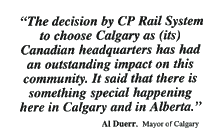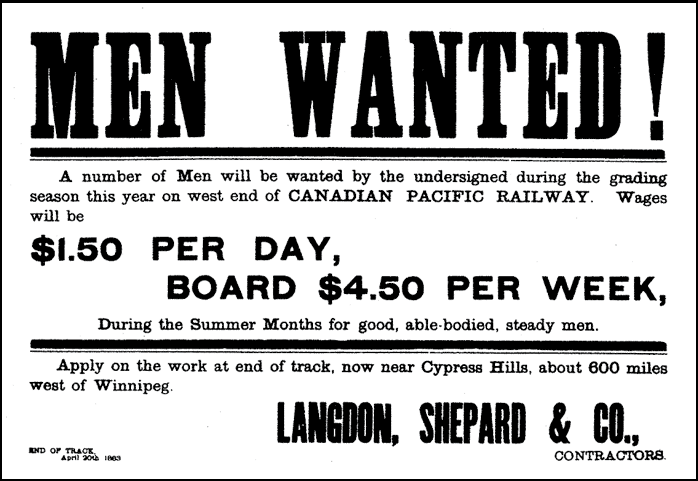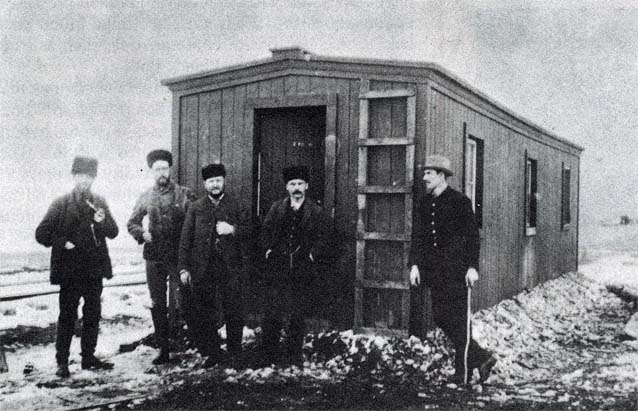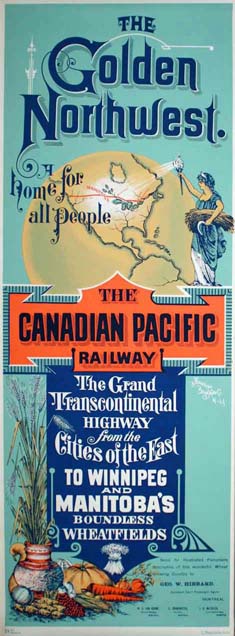


Locomotive 87 lurched to a halt.
As locomotive engineer Jim O'Hagan and fireman John "Scotty" Ormiston swung down from the cab, they marvelled at the burgeoning tent city lying on the east bank of the Elbow River.
O'Hagan was piloting the "front train" of the Canadian Pacific Railway Company's construction forces led by contractors Langdon and Shepard. The river had temporarily put a halt to their relentless advancement. End of track had reached Calgary.
Ten days earlier, John Egan, the railway's western superintendent, had advised W.C. Van Horne, then CPR general manager, "At Calgary on section 15, there is a very good location for a town site. No squatters are on this section, as the mounted police have kept them off there. Mr. Hamilton has arranged to lay out a town, and I have no doubt that when you see the place it will please you.
The message has been called Calgary's birth certificate.
As a direct result of Egan's assessment, the site would soon become the main agricultural and retail distribution point between Winnipeg and Vancouver, and, more than one hundred years later, headquarters of the Canadian Pacific Railway.
Shortly after the CPR was incorporated in 1881 to fulfil the federal government's obligation to build a transcontinental link with British Columbia, it entered into a contract with Langdon, Shepard, &Co., of St. Paul, Minnesota, to construct the section of track from Flat Creek, Manitoba, (near Brandon) to Fort Calgary, the site of a North West Mounted Police (NWMP) post established in 1875.
With the crossing of the Bow River on 10 Aug 1883 the terms of the contract were all but met, and the contractors discharged most of their men amid the tents and ramshackle wood frame structures of the fledgling Calgary community.
In later years, George Murdoch, Calgary's first mayor, elected in 1884, would say, "When the railroad arrived, our town was a newly discovered inhabited island on a landless oasis, on a desolate desert, all towns along the line having been made by the railroad with this exception."
In a manner of speaking, that was true. But the CPR was determined to control land sales in town sites along the line to partly offset its enormous construction costs. And Calgary was no exception.
Land speculation had been rampant along the proposed transcontinental route, and lots in section 14 on the east bank of the Elbow River had been selling briskly. But the CPR already had decided to locate its station in section 15 on the west bank of the river, an area which had been granted to the NWMP as grazing land. The police force's Fort Calgary and a few trading posts, among them I.G. Baker's, were the only manmade structures between end-of-track and the Rocky Mountains looming on the horizon.
While the bridge was constructed across the Elbow, many of the itinerant railway workers with time on their hands and many with bellies full of rotgut whisky, engaged in boisterous foot and horse races, letting off more steam than the idle locomotives which languished in the hot prairie sun.
A large contingent of workers, assuming their services would no longer be required by the railway after their discharge by the prairie contractors, clamored aboard flatcars headed back east. Strong threats by a gun-toting NWMP officer were necessary to persuade them that this was not in their best interests. Many signed on anew for the push that would take the end of steel as far as Laggan (now Lake Louise), until the construction season ground to a halt in the heavy snowfalls of the Rocky Mountains, just short of the summit.

When the bridge over the Elbow was completed, on 15 Aug 1883, the front train crossed over to the site now occupied by Palliser Square and began to put down sidings. As was a common practice when time and materials were in short supply, a surplus boxcar body was unloaded beside the main line and was quickly converted to the requirements of a frontier railway depot. The makeshift station put in a year of service while a more permanent two-storey structure was constructed.
Less than two weeks later, on 28 Aug 1883, the first official train arrived from Montreal with senior railway officials and directors of the company on board.
Among them were CPR President George Stephen (later Lord Mount Stephen) and the railway's irrepressible general manager, William Cornelius Van Horne, widely recognized as the "world's ablest railway general".
It was on this inspection tour that Van Horne hosted a dinner aboard his business car for Father Albert Lacombe, the near legendary Oblate missionary. Van Horne admired Lacombe for his courage and tenacity in winning the respect of the plains Indians. And on a more official level, he owed the priest a debt of gratitude for mediating a dispute between the CPR and Chief Crowfoot when the transcontinental line was approaching the Blackfoot Indian reserve near Gleichen, in what was then part of the Northwest Territories (now Alberta).
Included on the guest list were Stephen and CPR directors R.B. Angus and Donald A. Smith, along with their guests Baron Pascoe du P. Grenfell, one of the railway's European backers, and His Royal Highness, Prince Hohenlohe of Germany, who was scouting out the country's potential for prospective German emigrants.
For the course of the meal, Angus moved that Stephen vacate his position as president of the CPR in favor of Father Lacombe, a move that was quickly reciprocated when the priest installed Stephen as rector of his nearby mission of St. Mary's. "Poor souls of Calgary", Stephen is reputed to have said, looking out at the frontier community. "I pity you."
 The CPR, having been given
land grants in the odd numbered sections along the railway right-of-way was able to secure control of section 15 from the NWMP by way of an
Order-in-Council from the federal government. Intended purchasers submitted their names to the local CPR agent and names literally were picked
from a hat to determine who would get first choice of the best lots.
The CPR, having been given
land grants in the odd numbered sections along the railway right-of-way was able to secure control of section 15 from the NWMP by way of an
Order-in-Council from the federal government. Intended purchasers submitted their names to the local CPR agent and names literally were picked
from a hat to determine who would get first choice of the best lots.
While prospective landowners had to dig deep for the $450 necessary to buy a corner lot, $100, roughly two months pay for an unskilled laborer, was the price for all other lots.
In addition, the CPR offered a 50 percent rebate to buyers who erected buildings on their lots before April 1884.
The first name to be drawn, appropriately enough, was John Glenn, one of the oldest and most respected settlers in the area. More than 100 lots were grabbed up on the first day alone.
With the onset of winter, the town had begun to take shape upon a grid of streets named for the most part after CPR officers and directors.
As for the motley band of squatters and speculators who had settled on the east bank of the Elbow, many took a pragmatic approach to their situation, loading their flimsy buildings onto sleds and pulling them across the frozen river to new lots in the chosen townsite.
First to make the move was James Bannerman, postmaster and owner of the local feed and flour store. When the government was slow to respond to local requests to move the post office closer to the railway station, the CPR offered two free lots and $100 cash as an incentive. As for logistics, CPR chief engineer Herbert Holt, who 50 years later, would be one of the country's richest men and most influential industrialists took matters into his own hands.
Taking a team of bulls to the building, he dragged the post office to a site which was more pleasing to the local citizenry, and by happy coincidence, to the CPR as well.
By December 1883, the railway was operating a regular service between Winnipeg and Calgary. The following summer, sleeping cars were added to the trains, allowing well-heeled easterners to make the westbound trip in fine style. The town was officially incorporated that year.
Already a massive advertising program touting the merits of the "Golden Northwest" was under way to lure settlers from Eastern Canada, the U.S., and Europe.
In three years, the population of the little town nestled in the foothills of the Rocky Mountains had risen from less than 100 to 1,000. Business was booming. Trade with the East had grown apace. The future belonged to Calgary.

